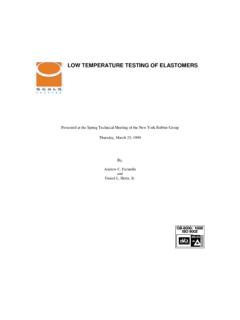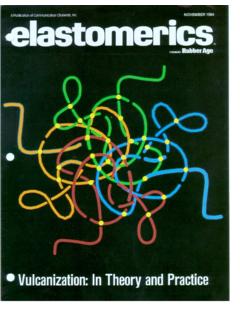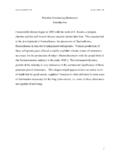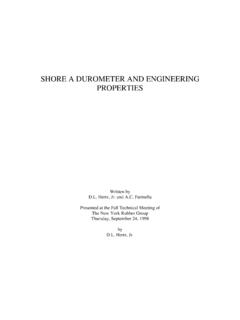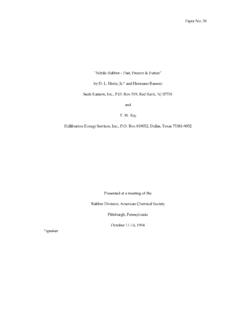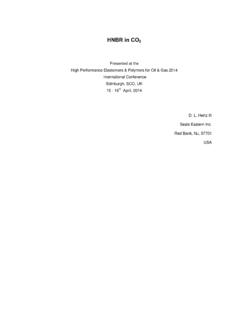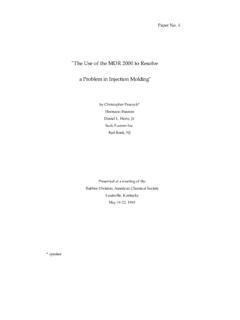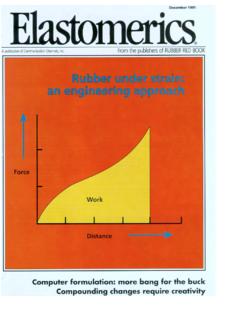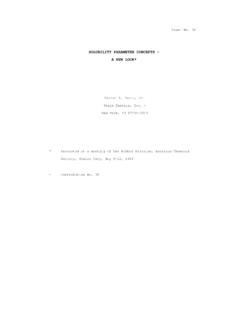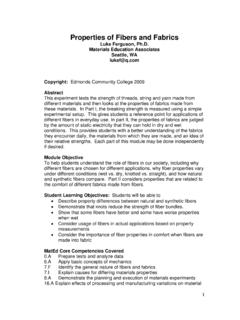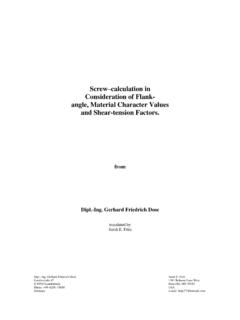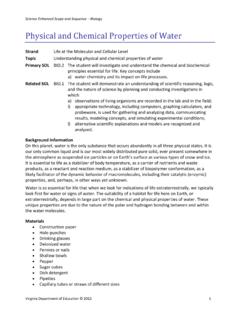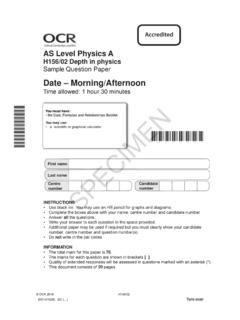Transcription of Elastomers for Steam - Seals Eastern
1 Elastomers for Steam Service Presented at the High Performance Elastomers & Polymers for Oil & Gas 2010 5th International Conference Aberdeen, Scotland 27th 28th April, 2010 D. L. Hertz III Seals Eastern Inc. Red Bank, NJ, 07701 USA Hertz III, , Elastomers for Steam Service , RAPRA (April 2010), 2 ABSTRACT Steam injection for enhanced oil recovery is a mature technique that will likely increase to satisfy future demand for crude oil. Graphite impregnated yarns have been successfully used to pack well-heads and injectors in such projects. Nevertheless, engineers still inquire on the use of high-temperature Elastomers for ease of assembly, replacement, and the promise of less compression-set than impregnated cords. In 1979, Brookhaven National Laboratory was commissioned by the Department of Energy to determine the best Elastomers for use in medium temperature geothermal wells with emphasis on binary plants in which isobutane is the working fluid.
2 The final stage of testing was conducted in brine, isobutane, and ASTM No. 1 oil in temperatures as high as 265 C (510 F). The tests, involving static o-rings with a MPa (3000 psi) differential across the seal, lasted 46 hours. The major conclusion was that the EPDM O-rings (L Garde ) are superior to the others tested in each of the three fluids. A few years later, a paper titled A proven Elastomer Compound for Extremely Hostile Geothermal and Oilfield Environments was present at the IADC/SPE 1983 Drilling Conference (New Orleans, LA). The presentation concluded that ..Y267 EPDM is the superior elastomer for high temperature aqueous reducing environments. There is one environment where Y267 EPDM is not a good choice, where there is free access to air or oxygen at high temperatures. This material has come to be known as a L Garde EPDM.
3 In the twenty-plus years since this noteworthy compound introduction, additional developments have taken place in FEPM and FFKM polymer compounds that warrant Hertz III, , Elastomers for Steam Service , RAPRA (April 2010), 3consideration for use in Steam . The objective of this paper is to examine some relatively recent Elastomers as well as the famed L Garde EPDM. INTRODUCTION Water possesses unique properties. Relevant to this study are some thermal properties of water. The boiling point, or the conditions at which it can exist as a liquid and vapor, is 100 C when at 1 atm. Elementary data, but it gets more interesting. At 100 C, the theoretical internal energy of the saturated liquid is kJ/kg while the theoretical internal energy of the saturated vapor is Thus, there is roughly six times more energy in a saturated vapor ( Steam ) than there is in the saturated liquid! As the pressure of the system increases, Steam tables indicate a substantial increase in internal energy of the saturated liquid and only marginal increases in the same for the saturated vapor.
4 For instance, the vapor pressure of water at 100 C is MPa. However, for a system at MPa pressure, the internal energy values of the saturated liquid and vapor are kJ/kg and kJ/kg respectively. Hence, boiler operators deliver more energy with Steam than with hot water. For purposes of this study, aging the test specimens in the vapor phase was of considerable importance. Water, also known as the universal solvent, has the ability to act as both an acid and a base. Although a very weak electrolyte on its own, water nevertheless undergoes ionic dissociation to a small extent by means of autoprotolysis2: Eq. (1) 2H2O (l) H3O+ (aq) + OH- (aq) Many so-called high temperature Elastomers are susceptible to degradation in the presence of a base. Temperature merely accelerates the inevitable reaction. The Hertz III, , Elastomers for Steam Service , RAPRA (April 2010), 4mechanism of dehydrohalogenation of the vinylidene fluoride monomer within an FKM composition is well documented.
5 Hertz III, in his paper titled Thermal Limitations of BPAF cured and TAIC cured Fluoroelastomers Evaluated using Strain Energy Density observed that FKM Type 1 and Type 2 polymers failed within 168 hours in deionized water at temperatures of 250 C (482 F) and higher. In this same study, Hertz III also concluded [t]he BPAF cure system is characteristically unstable in deionized water at temperatures of 225 C and above. 3 Thus, FKM class polymers and BPAF cured polymers have been excluded from the study. The ASTM D 20004 defines a framework for Elastomers to be classified for automotive applications. Heat resistance, under this specification, is determined by change in (1) tensile strength ( +/- 30% max), (2) change in elongation ( -50% max), and (3) change in hardness ( +/- 15 points max) at a given temperature after 70 hours of aging. These three attributes can be calculated by even the most uninitiated rubber laboratory.
6 These attributes taken individually, do not reflect the mechanical properties that determine whether an elastomer will function properly subsequent to thermal aging. Auda and Hazelton instead adopted Fractional Strain Energy at Break ( ), simultaneously taking into account tensile and elongation, as a means of examining the thermal stability of EPDM compositions5. Eq. (2) Fractional Strain Energy at Break = (TAB x EAB)aged / (TAB x EAB)original Hertz III, , Elastomers for Steam Service , RAPRA (April 2010), 5where TAB is tensile at break and EAB is elongation at break. The author has taken liberty to apply this same framework in examining the aged samples. Objective The primary objective was to provide data on the effects of high temperature saturated Steam on Elastomers recommended for high temperature service. It should be noted that these materials are being aged at temperatures exceeding their recommended limits.
7 One exception is the PFR 95 HT which is designed to handle service at 300 C (572 F). Scope Elastomers : Four proprietary compounds formulated, using commercially available Elastomers , were selected. All four compounds utilize a peroxide induced cure. Only polymers that might be recommended for use in Steam were examined. The compound attributes, or baseline data, as compiled from D412 dumbbells, is reported in Table 1. Base Polymer Designation D412 Stress @ BreakD412 Elongation @ Break Shore-A DurometerAflas 100H TFE/P MPa (3349)49% 92 EP terpolymer EP (Y-267) MPa (3124)138% 84 Viton Extreme TFE/E/PMVE MPa (2919)157% 84 PFR 95HT FFKM MPa (2498)99% 87 Table 1. Hertz III, , Elastomers for Steam Service , RAPRA (April 2010), 6 Environment: The thermal stability of the Elastomers in Table 1 was examined in saturated Steam . The materials were aged at temperatures known to represent or exceed the outer thermal limit of their respective ASTM category, with the exception of the FFKM.
8 Testing temperatures were 250 C (482 F) and 275 C (527 F). EXPERIMENTAL Method AS568-214 o-rings of the subject materials were mounted on mandrels with accommodating glands and were then subsequently installed in a bore (see fig 1) to act as static rod Seals . These fixtures were then placed in gray iron vessels with carbon steel caps atop a positioning device whose function was to maintain the fixture within the vapor phase (see fig 2). The test vessels were partially filled with de-ionized water. Fig. 1 O-ring Mandrel, compression sleeve, and gland; Fig 2 Complete assembly. Hertz III, , Elastomers for Steam Service , RAPRA (April 2010), 7 ASTM dumbbells were suspended, in the vapor phase, of similar gray iron test vessels that were partially filled with de-ionized water. Test Parameters Variables such as sample size, test conditions, temperatures, aging period and specimens tested are presented in Table 2.
9 Aging period 168 hours 336 hours Test Specimen ASTM D412 dumbells, n = 46 AS568-214 O-rings, n = 4 Test media Deionized Ultra Filtered water Test Temperature 250 C 275 C Table 2: Experiment test matrix Measurements The experiment was designed to age AS568-214 o-rings in a saturated Steam subject to the mechanical demands that Seals within a Steam injector would experience. Using o-rings would allow relevant visual examination, compression set measurement, and strain energy measurements. The aging of ASTM dumbbells would facilitate DMRT analysis for changes in viscoelastic response under shear and the compilation of conventional stress-strain data under tension. Hertz III, , Elastomers for Steam Service , RAPRA (April 2010), 8 DMRT / Shear Modulus At its simplest level, an elastomer ages individually or through some combination of three basic mechanisms: chain scission, crosslink scission, and/or crosslink addition.
10 Kuhn developed an equation ( ) for shear modulus that describes the effect of these Eq. (3) G = NkT = RT / Mc Under this equation, shear modulus (G) is directly proportional to the number of polymer chains per unit volume (N) at a given temperature (T - Kelvin), where (k) equals Boltzmann s constant. Similarly, shear modulus is proportional to the material s density ( ) at a given temperature and inversely proportional to the molecular weight between crosslinks (Mc) where (R) is the universal gas constant. DMRT Thermal Sweeps were run from 0C to 200C at a frequency of , at a strain. The temperature change was run at 5C/min. Strain Energy: Fractional strain energy ( ) describes an aged vulcanizate in terms of both its integrity (retained tensile) and its extensibility (retained elongation). Use of fractional (or retained) strain energy has been shown to be a reliable means of characterizing and projecting aging behavior of EP rubbers as previously demonstrated by Auda and Hazleton.
